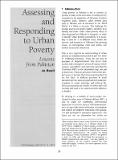| dc.contributor.author | Beall, Jo | en |
| dc.date.accessioned | 2016-02-24T15:33:52Z | |
| dc.date.available | 2016-02-24T15:33:52Z | |
| dc.date.issued | 01/04/1997 | en |
| dc.identifier.citation | Beall, J. (1997) Assessing and Responding to Urban Poverty: . IDS Bulletin 28(2): 58-67 | en |
| dc.identifier.issn | 1759-5436 | en |
| dc.identifier.uri | https://opendocs.ids.ac.uk/opendocs/handle/20.500.12413/9212 | |
| dc.description.abstract | Summaries Pakistan provides an interesting challenge to poverty analysts and policy makers concerned with urban poverty because urban poverty is neither as extensive nor as visible as in rural areas of the country, or as in the cities of other South Asian countries such as India. Urban poverty does exist, however, and is bound to increase. The challenge is to make it visible, which requires looking for it in different ways. The article draws on micro studies conducted in Rawalpindi and Karachi during 1993 as part of a study towards the Pakistan Poverty Assessment (World Bank 1995). It demonstrates the value of a participatory assessment approach to the study of poverty and as a supplement to rather than substitute for conventional measurements of poverty which focus on income and consumption poverty or on human development indicators. It does so by revealing processes which influence the ways in which low income groups in cities can escape from or fall into poverty. An argument is made for understanding urban poverty as a multidimensional process which needs to be understood in relational and spatial terms and which is closely related to processes which foster insecurity and social exclusion. In policy terms, anti?poverty strategies which address the issue of secure livelihoods and liveable environments are recommended as indispensable components of broader poverty reduction strategies which address income and consumption poverty and basic needs. Thus a multi?dimensional approach is advocated, not only in terms of analysis but policy action as well, and one which addresses institutions and social relations, particularly those operating at or on the metropolitan level. It is argued that this multidimensional and interdisciplinary approach is particularly important in the urban context, where it is possible for policy to build on the resources of low income people themselves. However, by the same token, cities are also sites of extreme vulnerability and insecurity and policy needs to address causal factors here too, including social institutions built on asymmetrical power relations. | en |
| dc.format.extent | 10 | en |
| dc.publisher | Institute of Development Studies | en |
| dc.relation.ispartofseries | IDS Bulletin Vol. 28 Nos. 2 | en |
| dc.rights.uri | http://www.ids.ac.uk/files/dmfile/IDSOpenDocsStandardTermsOfUse.pdf | en |
| dc.title | Assessing and Responding to Urban Poverty: | en |
| dc.type | Article | en |
| dc.rights.holder | © 1997 Institue of Development Studies | en |
| dc.identifier.doi | 10.1111/j.1759-5436.1997.mp28002006.x | en |

